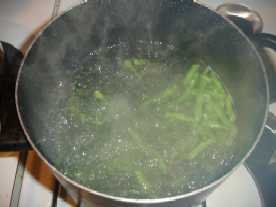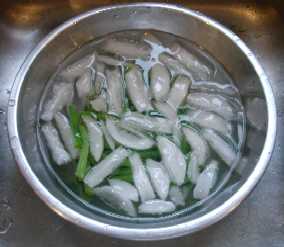
Looking for Blanching: What it is, Why to blanch before freezing and drying vegetables and fruits, and How to blanch! in 2025? Scroll down this page and follow the links. And if you bring home some fruit or vegetables and want to can, freeze, make jam, salsa or pickles, see this page for simple, reliable, illustrated canning, freezing or preserving directions. There are plenty of other related resources, click on the resources dropdown above. If you are having a hard time finding canning lids, I've used these, and they're a great price & ship in 2 days.
If you have questions or feedback, please let me know! There are affiliate links on this page. Read our disclosure policy to learn more.
Blanching: What it is, Why to blanch before freezing and drying vegetables and fruits, and How to blanch!
Blanching is scalding vegetables in boiling water or steam for a short time as an important step prior to vegetables being frozen. Blanching stops enzyme actions which can cause loss of flavor, color and texture. Up until harvest time, enzymes cause vegetables to grow and mature. If vegetables are not blanched, or blanching is not long enough, the enzymes continue to be active during frozen storage causing off-colors, off-flavors and toughening.
Blanching
- Slows or stops enzymatic action, preserving flavor, color and texture,
- cleanses the surface of dirt, bacteria, molds and other organisms,
- brightens the color,
- helps retard loss of vitamins and
- softens vegetables and makes them easier to pack and less susceptible to freezer burn
Blanching time is crucial and varies with the vegetable and size. Under-blanching actually stimulates the activity of enzymes and is worse than no blanching. Over-blanching causes loss of flavor, color, vitamins and minerals. Follow recommended blanching times below or attaches to each relevant recipe (blanching applies to freezing and many drying recipes, but not to canning; since canned foods are effectively blanched during the heat treatment in the canner)
How to Blanch vegetables and fruits
Water Blanching
For home freezing, the most satisfactory way to heat all vegetables is in boiling water. Use a blancher which has a blanching basket and cover, or fit a wire basket into a large pot with a lid.
Use one gallon water per pound of prepared vegetables.
- Put the vegetable in a blanching basket and lower into vigorously boiling water over high heat. Place a lid on the blancher. If you don't have a basket, just dump them into the pot as shown in the photo.
- The water should return to boiling within 1 minute, or you are using too much vegetable for the amount of boiling water. Start counting the blanching time as soon as the water returns to a boil. Keep heat high for the time given in the directions for the vegetable you are freezing. (See further down the page for blanching times)
- As soon as blanching is complete, vegetables should be cooled quickly and
thoroughly to stop the cooking process. To cool, pl
 nge the basket of
vegetables immediately into a large quantity of ice water, 60ºF or below.
If you didn't use a basket, just pour the pot into a colander in the
sink then dump the strained vegetables into the ice water. If ice is
used, about one pound of ice for each pound of vegetable is needed. Cool the
vegetables for the same length of time that you blanched them; or longer if
they are still warm..
nge the basket of
vegetables immediately into a large quantity of ice water, 60ºF or below.
If you didn't use a basket, just pour the pot into a colander in the
sink then dump the strained vegetables into the ice water. If ice is
used, about one pound of ice for each pound of vegetable is needed. Cool the
vegetables for the same length of time that you blanched them; or longer if
they are still warm.. - Drain vegetables thoroughly after cooling. Extra moisture can cause a loss of quality when vegetables are frozen. Simply pouring them into a strainer or colander in your sink and leting them drain for 2 or 3 minutes is fine.
Steam Blanching
Heating in steam is recommended for a few vegetables. For broccoli, pumpkin, sweet potatoes and winter squash, both steaming and boiling are satisfactory methods. Steam blanching takes about 11/2 times longer than water blanching.
To steam, use a pot with a tight lid and a basket that holds the food at least three inches above the bottom of the pot. Put an inch or two of water in the pot and bring the water to a boil.
Put the vegetables in the basket in a single layer so that steam reaches all parts quickly. Cover the pot and keep heat high. Start counting steaming time as soon as the lid is on. See steam blanching times recommended for the vegetables listed below.
Microwave Blanching
Microwave blanching may not be effective, since research shows that some enzymes may not be inactivated. This could result in off-flavors and loss of texture and color. Those choosing to run the risk of low quality vegetables by microwave blanching should be sure to work in small quantities, using the directions for their specific microwave oven. Microwave blanching will not save time or energy.
Blanching Times*
| Vegetable | Blanching Time (minutes) |
|---|---|
| Artichoke-Globe (Hearts) |
7 |
| Artichoke-Jerusalem | 3-5 |
| Asparagus Small Stalk Medium Stalk Large Stalk |
2 3 4 |
| Beans-Snap, Green, or Wax | 3 |
| Beans-Lima, Butter, or Pinto Small Medium Large |
2 3 4 |
| Beets | cook |
| Broccoli (flowerets 11/2 inches across) Steamed |
3 5 |
| Brussel Sprouts Small Heads Medium Heads Large Heads |
3 4 5 |
| Cabbage or Chinese Cabbage (shredded) |
1 1/2 |
| Carrots Small Diced, Sliced or Lengthwise Strips |
5 2 |
| Cauliflower (flowerets, 1 inch across) |
3 |
| Celery | 3 |
| Corn Corn-on-the-cob Small Ears Medium Ears Large Ears Whole Kernel or Cream Style (ears blanched before cutting corn from cob) |
7 9 11 4 |
| Eggplant | 4 |
| Greens Collards All Other |
3 2 |
| Kohlrabi Whole Cubes |
3 1 |
| Mushrooms Whole (steamed) Buttons or Quarters (steamed) Slices steamed) |
5 3 1/2 3 |
| Okra Small Pods Large Pods |
3 4 |
| Onions (blanch until center is heated) Rings |
3-7 10-15 seconds |
| Peas-Edible Pod | 1 1/2-3 |
| Peas-Field (blackeye) | 2 |
| Peas-Green | 1 1/2 |
| Peppers-Sweet Halves Strips or Rings |
3 2 |
| Potatoes-Irish (New) | 3-5 |
| Pumpkin | cook |
| Rutabagas | 3 |
| Soybeans-Green | 5 |
| Squash-Chayote | 2 |
| Squash-Summer | 3 |
| Squash-Winter | cook |
| Sweet Potatoes | cook |
| Turnips or Parsnips Cubes |
2 |
*blanching times are for water blanching unless otherwise indicated.
Illustrated Canning, Freezing, Jam Instructions and Recipes
[ Easy Home Canning Directions] [FAQs - Answers to common questions and problems] [Recommended books about home canning, jam making, drying and preserving!] [Free canning publications to download and print]
Looking for canning equipment and supplies?
Water bath canner with a jar rack
Pressure canners for gas, electric and induction stoves: Presto 23Qt or T-fal 22Qt
Canning scoop (this one is PERFECT)
Ball Blue book (most recent version)
Jars: 8oz canning jars for jams
Find Other types of farms:
Farm markets and roadside stands
Road trips and camping resources
Local Honey, apiaries, beekeepers
Consumer fraud and scams information
Home canning supplies at the best prices on the internet!
Maple Syrup Farms, sugarworks, maple syrup festivals
Environmental information and resources
Farms For Your Event for birthday parties, weddings, receptions, business meetings, retreats, etc.
Festivals - local fruit and vegetable festivals
Get the
most recent version of
the Ball Blue Book
With this Presto 23 quart pressure canner and pressure cooker, you can "can" everything, fruits, vegetables, jams, jellies, salsa, applesauce, pickles, even meats, soups, stews. Model 01781

You can make jams, jellies, can fruit, applesauce, salsa and pickles with water bath canners, like this Granite Ware 12-Piece Canner Kit, Jar Rack, Blancher, Colander and 5 piece Canning Tool Set

